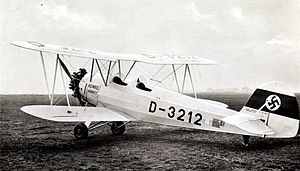Heinkel He 72
| Heinkel He 72 cadet | |
|---|---|

|
|
| Type: | School and training aircraft |
| Design country: | |
| Manufacturer: | |
| First flight: |
1933 |
| Production time: |
1933-1937 |
| Number of pieces: |
768 |
The Heinkel He 72 Kadett was a German training and touring aircraft produced by the Ernst Heinkel Flugzeugwerke .
history
The He 72 was designed in 1933 by Paul John Hall as a wooden double-decker . This design was based on a project Hall developed under the designation P1020 for Bayerische Flugzeugwerke until they went bankrupt. The machine could be used for aerobatics and as a touring aircraft. The model aircraft He 72 A and He 72 B were equipped with an Argus-As-8-R - in- line engine and a Siemens-Sh-14 - radial engine. Series machines were given the Siemens Sh 14 motorization. As part of the development of the He 172 , some of the He 72 were equipped with Townend-Ring engine covers and wheel covers. These were given the designation "special cadets".
use
In the summer of 1934 negotiations took place with the Swiss Air Force to agree on a license to build. However, the contract did not materialize. In 1936 six He 72s were delivered to Bulgaria. The German Amazon expedition of 1936/37 used one of the He 72s with floats. This He 72 D (factory number 604) with the registration D-EFON, proved itself under these difficult conditions. In the Luftwaffe, the He 72 was one of the most popular training aircraft for beginners. In May 1940 there were 629 in the Luftwaffe's inventory, in January 1944 there were still 417 copies. In 1937 an He 72 was used to test auxiliary launch missiles ; these auxiliary launch missiles were equipped with a drive developed by Hellmuth Walter . The attempts were successful.
Production numbers
Series production of the He 72 began in March 1934 and ended in September 1937. In December 1934, production was transferred from Heinkel to Fieseler.
| year | Heinkel | Fieseler | total |
|---|---|---|---|
| 1933 | 2 | 2 | |
| 1934 | 271 | 3 | 274 |
| 1935 | 116 | 116 | |
| 1936 | 262 | 262 | |
| 1937 | 114 | 114 | |
| total | 273 | 495 | 768 |
construction
The fuselage structure consists of a tubular steel frame with fabric covering. The supporting structure was made of wood with fabric covering. The elevator and rudder units were also made of wood. A tail wheel chassis was used for the chassis . A four-cylinder in- line Argus As 8 R engine with 150 hp or the Siemens Sh 14 radial engine was used as the engine.
Versions
- He 72 A: Pre-production aircraft with a four-cylinder in-line Argus As 8 R engine with 150 hp.
- He 72 L: (B-series) series version with a covered chassis, radial engine BMW-Bramo Sh 14 A with 160 HP and a Townend-Ring engine fairing. Used as a training aircraft in the Air Force.
- He 72 W: Sea version with floats instead of landing gear.
Technical specifications
| Parameter | Data He 72 |
|---|---|
| crew | 2 |
| span | 9.00 m |
| length | 7.50 m |
| Altitude in flight attitude | 2.70 m |
| Wing area | 20.70 m² |
| Empty mass | 524 kg |
| Flight mass | 820 kg |
| Payload | 296 kg |
| fuel | 110 l |
| Engine | 1 × Siemens Sh 14 with 168 PS (124 kW) |
| Top speed | 194 km / h |
| Landing speed | 77 km / h |
| Climbing time to 1000 m | 3.7 min |
| Service ceiling | 5000 m |
| Range | 820 km |
See also
literature
- Volker Koos: Ernst Heinkel Flugzeugwerke 1933–1945 . Heel, Königswinter 2003, ISBN 3-89880-217-5 , p. 42/43 .
- H.Beauvais / K.Kössler / M.Mayer / C.Regel: The German flight test centers until 1945 . Bernard & Graefe, Bonn 1998, ISBN 3-7637-6117-9 .
Web links
Individual evidence
- ↑ Volker Koos: Ernst Heinkel Flugzeugwerke 1933–1945 , p. 43, S. Heel Verlag, Königswinter, 2003
- ↑ Volker Koos: Ernst Heinkel Flugzeugwerke 1933–1945 , pp. 42–43, S. Heel Verlag, Königswinter, 2003
- ↑ H.Beauvais / K.Kössler / M.Mayer / C.Regel: The German flight test points to 1945 . P. 218 Bernard & Graefe Verlag, Bonn 1998
- ↑ Documents from the Federal Archives / Freiburg Military Archives, holdings RL 3. The book Nagel, Rolf / Bauer, Thorsten: Kassel and the aviation industry since 1923, Melsungen 2015, p. 232, names slightly different production figures for Fieseler for the individual years (1934: 0, 1935: 137, 1936: 252, 1937: 106), but the total number also comes to 495 aircraft
- ↑ EHF data sheets No. 547 and 548 from September 1, 1933
